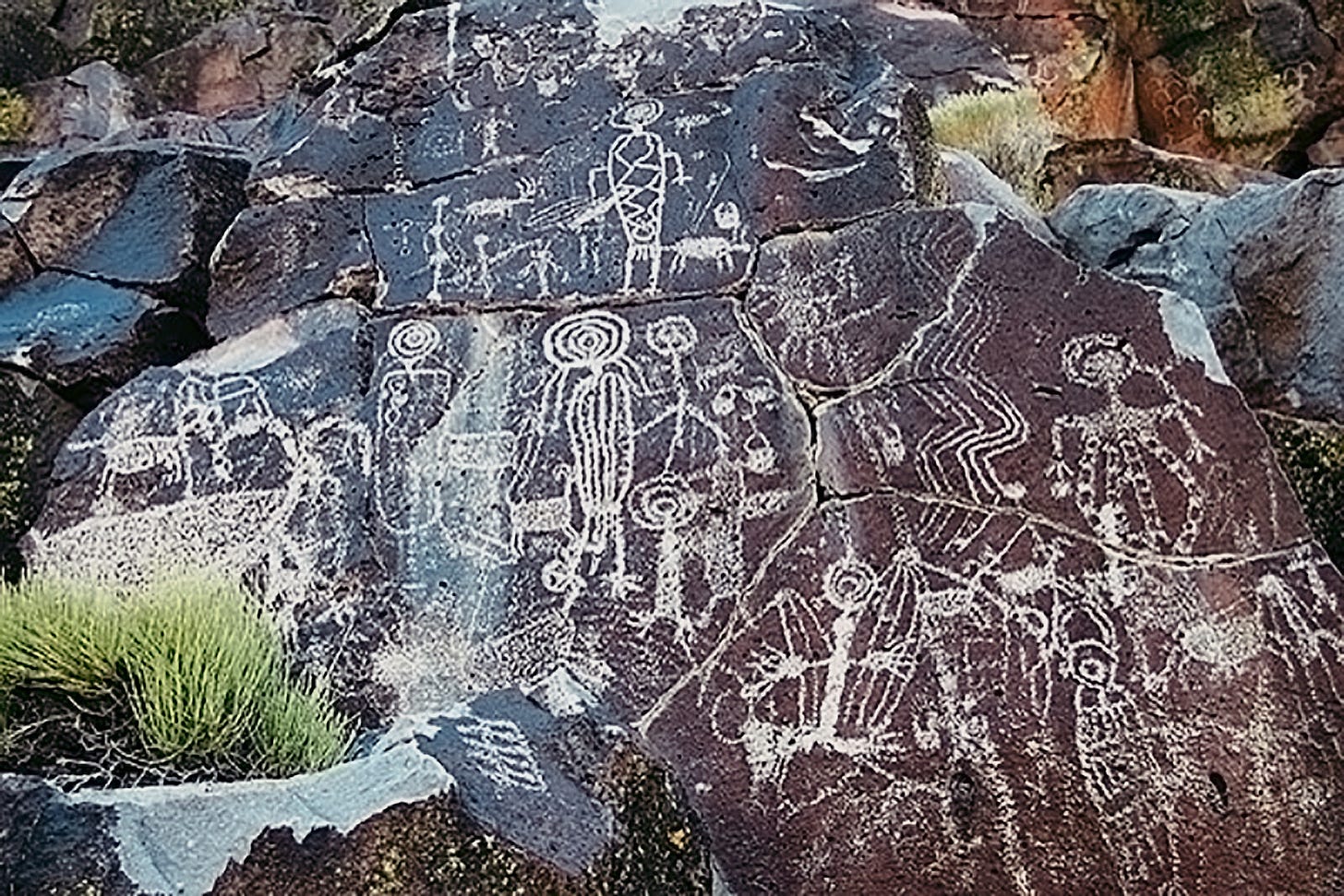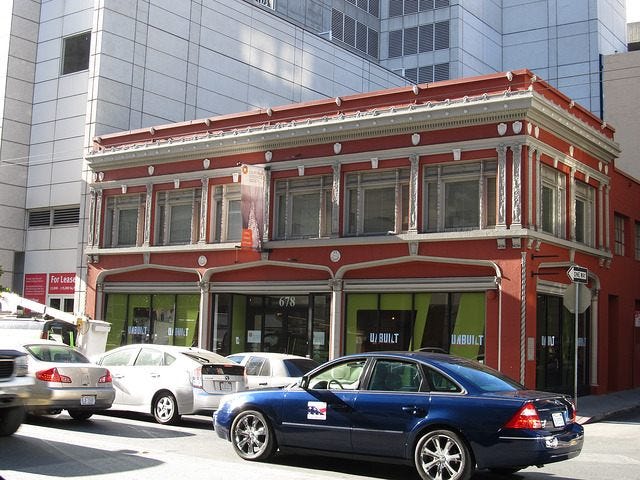Interesting Historical Places in California (pt 2)
A list and explanation of some interesting historical places in California... again
Hi, this is a part 2, so I’m just going to post the same intro from the part 1.
Let me start by saying that “interesting” is a subjective word, meaning that whether or not you think these places were interesting, it doesn’t matter, because I’m the writer and I do find them interesting. That sounds a bit rude, but to be fair, I’m a bit of a nerd, so what I find interesting might not apply to everyone, but if you’re reading this it’s likely because you opened a link or subscribed to my Substack, which means you ar least knew a little bit what you were getting into. All that nonsense being said, let’s dive in!
Without further ado, let’s get started! … again
Cleveland Cascade in Lake Merritt, Oakland, California
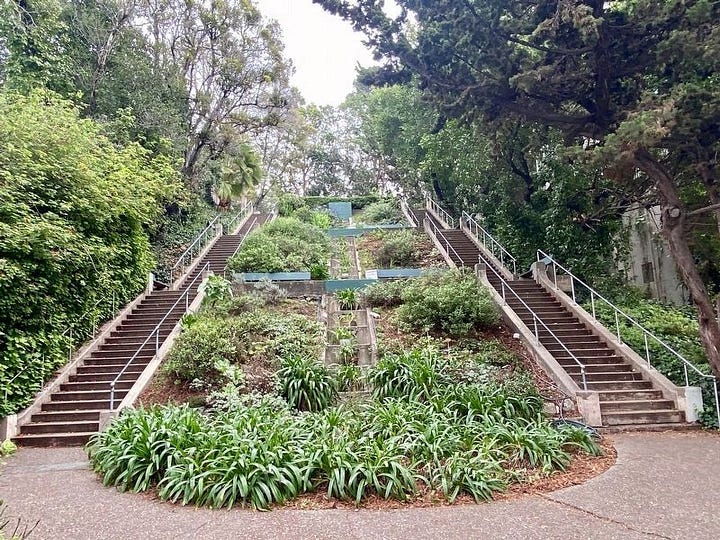

The Cleveland Cascade was built in 1923 and was modeled after a fountain in Italy. The landscape architect was Howard Gilkey, and the fountain featured 20 concrete bowls that descended in a stair pattern, each set with a basin and seashell ornaments. An electric pump allowed water to cycle back up to the top of the structure, colored lights illuminated the descent. However, it became neglected in the 1950s, the water was shut off and the fountains dried out. The decorative seashells were removed and the basins were filled with dirt. But in 2004, a group of volunteers used photographs they found in old newspapers and used hand tools to excavate the basins. New lights were installed, more attractive landscapes and a historical plaque were added. Upkeep of the fountain is now handled by a volunteer group that wishes to reserve the functionality of the fountain.
Coso Rock Art District in Inyo County, California
Near a Naval Air Weapons Station called China Lake, in the vast desert landscape there are some of the oldest and most plentiful examples of Native American rock art. The Mojave Desert was believed to be inhabited by early indigenous people as far back as 13,500 years ago. This area is one of the earliest settlements in all of North America. There are 90 square miles characterized by an abundance of ancient petroglyphs. There are around 100,000 petroglyphs scratched or ground into the basalt rock faces. The pictures show bighorn sheep, reptiles, human hunters, and different symbols. They were possibly territorial markers or may have been used to tell time. They also could have been visual educators, but experts are yet to settle on a definite hypothesis. Although the area was thought to be inhabited 13,500 years ago. Dating techniques have dated the drawings somewhere between 10,000 to even possibly 19,000 years ago. They could have been created not very long after the first humans arrived in North America at the end of the last ice age. Prehistoric Coso people may have originated the style which eventually spread to nearby regions. The oldest ones date back to the Paleoindian period. More carvings were added throughout thousands of years. Then, in the 1940s, the US Navy took control of the area. Surprisingly, not all of the drawings have been accounted for but there are still around 100,000 estimated to be in the area.
California Historical Society Headquarters in San Francisco, California
This building is located in what used to be an E. M. Hundley hardware store in Yerba Buena and painted “International Orange” which is the same color as the Golden Gate Bridge. The society, housed in the building, was founded in San Francisco’s financial district in 1871 but was not recognized until 1979. The building is a neighbor to the San Francisco Museum of Modern Art, which can lead to it being overlooked. It houses a collection of thousands of rare publications and exceptional photographs, including postcards, posters, and advertisements. There is also a card catalog of the North Baker Research Library, as well as the Ten Lions Bookstore, which features local and tourist-friendly selections of San Francisco and Golden State-themed books, clothes, and mementos.
El Campo Santo Cemetary in Old Town San Diego, California

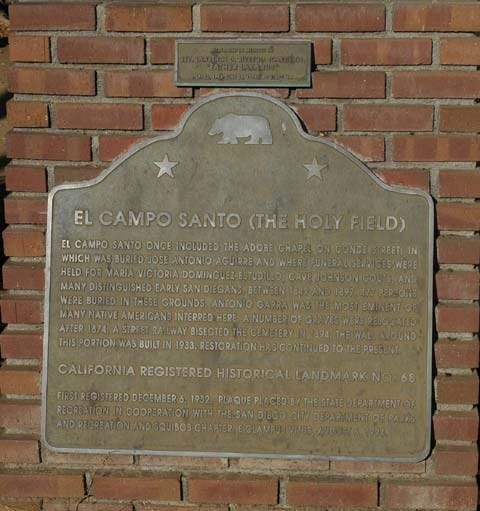
This historic cemetery is located in Old Town San Diego, and it is only a small portion of its original size. Some of the graves at this cemetery were moved, while others were just paved over to create roads for street cars. Because they were paved over, a theory was started that the cemetery is now haunted by the trapped souls in the cemetery. The existing grave markers tell stories of Native American uprisings, and life stories of some of San Diego’s earliest residents. Some very vague tombstones only say things like, “Little Girl Rest in Peace".” One notable grave would be Yankee Jim Robinson, who stole a boat in San Diego Bay in the mid-1800s and was sentenced to death by hanging. Jim didn’t take his sentencing seriously and was still talking as the cart that hung him pulled away. Jim was hung on the land that now contains the Whaley House. There are several burial sites located outside the cemetery, along San Diego Avenue, as well as the sidewalk out front, marked with brass medallions that read “Grave Site.”
John Muir’s Giant Sequoia in Martinez, California
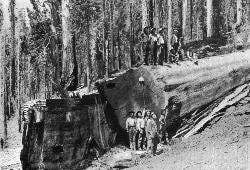

Located in Martinez, California, outside a Victorian-period Italianate mansion where John Muir spent the last 24 years of his life, stands a tree that is almost 140 years old. Considering its ancestors, this tree is very young. Sequoias can live to be thousands of years old. John Muir referred to sequoias as “big trees," and while on a trip to the Sierra Nevadas in 1885 Muir found a giant sequoia seedling and wrapped it in a moistened handkerchief, transported it to his property in Martinez, and planted it there. That property is now designated as the John Muir National Historic Site. Muir’s in-laws lived in the house at the time and maintained an orchard on the land. Muir eventually moved to the house there with his family in 1890 and nurtured the tree until his death, in 1914. By 1969 the tree had grown to the height of the roofline, however, sequoias struggle in the soil and climate of the Bay Area, and they do better in the Sierra Nevada, with high altitude, rocky soil, and wintery weather. The tree is infected with an incurable regional fungal disease that attacks its vascular system and makes it difficult for the tree to absorb water and nutrients. In 2010 the tree was determined to be seriously ill and unlikely to recover. Horticulturists began to attempt to clone the tree to preserve it and maintain the unique connection to the famous naturalist. These initial attempts were unsuccessful. But in 2013, the US National Park Service partnered with the Archangel Ancient Tree Archive in Copemish, Michigan, 15 cuttings were taken from the tree’s crown and were shipped to Michigan for cloning. Within 6 months, the cuttings sprouted roots and now there are miniature sequoia clones safely growing in pots in Michigan, waiting to be replanted when the time comes. The site in Martinez is open 7 days a week from 10 am-5 pm. There is no entrance fee.
Emperor Norton Plaque in South San Francisco, California


Located in Molloy’s Tavern in Southern San Francisco, is a plaque dedicated to the self-proclaimed “Emperor of United States.” Joshua Abraham Norton was born in England and raised in South Africa, where he lived until his late 20s. Norton moved to California during the gold rush, where he eventually settled in San Francisco. He soon became a wealthy, influential, and respected citizen. He thought of a business venture to buy Peruvian rice to sell to the Chinese during a shortage. The business went belly-up in the 1850s and he went bankrupt. In September 1859, he charted a new path and declared himself the Emperor of the United States. He wore an increasingly elaborate uniform with large, gold-plated epaulets and a beaver hat decked out with feathers. He began making predictions that many of his contemporaries regarded as outrageous and ridiculous. The Emperor sold his own currency, which was accepted as legal tender in places that he frequented. He made the prescient claim with three newspaper proclamations in 1872 that San Francisco and Oakland should be connected by a bridge via Yerba Buena Island. It took another 64 years for this to happen with the San Francisco-Oakland Bay Bridge on November 12th, 1936. The Emperor never saw this come to fruition, as he died in 1880. The Clampers commissioned a plaque to be dedicated in his honor, designed by William Gordon Huff, and unveiled as San Francisco’s new Transbay Terminal on February 25, 1939. The terminal was originally made for trains, and eventually also used for buses, that crossed the Bay Bridge from the East Bay. The plaque wasn’t formally installed anywhere for another 16 years when the Clampers placed it across the city at the Cliff House in 1955. The Clampers eventually moved the plaque to the Transbay Terminal in November of 1986, in connection with the 50th anniversary of the Bay Bridge. When the terminal was being prepped for demolition in 2010, the plaque was placed in storage. The terminal was replaced by the Salesforce Transit Center in 2018 and the plaque was refurbished at the de Young Museum. The Clampers rededicated the plaque on September 7th, 2019, inside the Transit Center, only for the plaque to be vandalized a year later, forcing it to be removed. In June of 2021, the plaque was installed inside Molloy’s Tavern in South San Francisco, which borders Colma, the city in which Emperor Norton is buried, in Woodlawn Cemetery. Some decades after the original plaque dedication in 1939, the date on the plaque, which reads August 18, 1869, was revealed to have been the date of a fake proclamation, which was published as a joke by the Oakland Daily News. The “proclamation” claimed the Emperor called for a bridge from Oakland to Yerba Buena Island to Sausalito to the Farallon Islands, or the original bridge to nowhere.
Dan the Miner Statue in Los Angeles, California
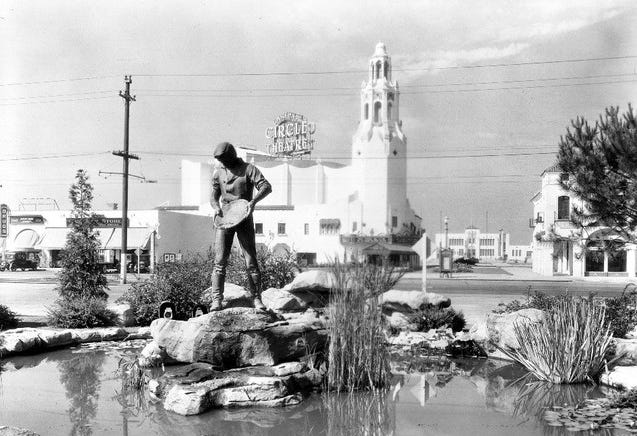
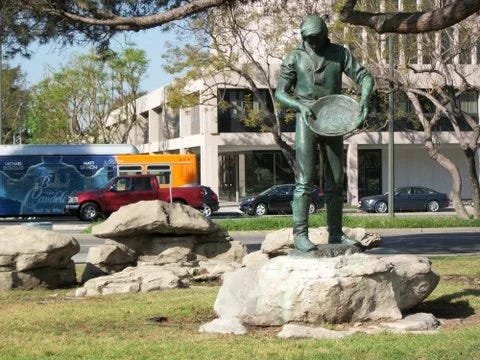
Dan the Miner is a 7-foot-tall statue modeled after Dan O’Connel McCarthy, who came to California in 1869. The statue is said to be a memorial to the pioneer spirit. The statue was originally placed near the Carthey Circle Theater Movie Palace but was moved when the theater was demolished in 1969, 100 years after the original Daniel first arrived. The statue was moved to Carthey Circle Park. It depicts Daniel McCarthy, who is focused on his gold pan. He was originally surrounded by a large pond, but that was replaced by a gravel pathway in 1969. Honestly, the pond makes a lot more sense. The sculpture was created by Henry Lion, it weighs over 500 lbs and was erected in 1925 by a number of the Native Sons of the Golden West, an occasionally controversial fraternal organization founded in 1875. Daniel McCarthy was born in North Carolina in 1830. The statue honors McCarthy for his “mining exploits” and being “a patriot.” Daniel was the editor of the American Flag, a newspaper in San Francisco, he decried slavery and even supported women’s rights. But on Christmas day in 1862, he shot a man, John A. Davis, in cold blood. Davis was dining at a restaurant in Sonora, California when McCarthy entered and opened fire. The men struggled before two more shots were fired. The feud was over the death of McCarthy’s friend, followed by David foreclosing on the office McCarthy owned. David also accused McCarthy of desertion from the US Army, and Davis was collecting evidence to support his case. After the gold rush, there were allegations of corruption around McCarthy’s mining and real estate interests in San Diego, but those seemed to be centered around his son John Harvey, nicknamed “Get-Rich-Quick-Harvey.” John Harvey was always in trouble, but he always seemed to get out of it. McCarthy lived to 88 years and was buried at the Hollywood Forever Cemetery in 1919. In 2008, the statue was stolen but was found cut in half at the waist, likely to make it easier to move. The statue was returned in early 2009.
To wrap up, these are only a few interesting places in California. If you’re ever curious or want to find other interesting places, one good source is to go to the website of the Clamper Chapter local to where you are and search for plaques. They usually have a list available. I want to add that throughout taking notes and writing these last two articles, I could smell a small scent of cigars every time I read or typed the words “Yerba Buena” I could smell a small scent of cigars. It makes me miss my grandfather. Papa, if you’re reading this, I hope I can come see you soon! For everyone else, if you’d rather hear about historical places in person, you can always visit your nearest Clamper bar. They’d love to talk your ear off about the local history.
My next article is a mystery even to me because I cannot find my idea book right now.



